SOMMARIO:
A. EVENTI
1. CYCLE DE CONFERENCES SUR LE THEME “MONASTERES COPTES DES DESERTS ET DES VILLAGES: ARCHITECTURE DEFENSIVE ET ESPACES SACRES (Ve-XIXe S.)” (PARIS, 21.11.2017-13.02.2018)
2. COLLOQUE: “DISCIPLE DE NUIT. LA FIGURE BIBLIQUE DE NICODEME” (PARIS, 24-25.11.2017)
3. PRESENTATION DE CH. MESSIS SUR LE THEME: “PRATIQUES SOCIALES ET DISCOURS NORMATIFS A’ BYZANCE (IVe-XVe SIECLE) (PARIS, 07.12.2017)
4. PRESENTAZIONE DEL VOLUME “STUDI BIZANTINI IN ONORE DI MARIA DORA SPADARO” (CATANIA, 11.12.2017)
5. VORTRAG VON DR. D. STATHAKOPOULOS: “BUYING SALVATION: THE MOTIVATIONS FOR FOUNDATIONS AND ENDOWMENTS IN THE LATE BYZANTINE WORLD” (WIEN, 12.12.2017)
6. CONFERENZA: “LIBRI GRECI A VENEZIA (2): UNA BIBLIOTECA D’AUTORE. GIORNATA DI STUDI IN ONORE DI MARIO VITTI” (VENEZIA, 16.12.2017)
7. COLLOQUE INTERNATIONAL: “POESIE, BIBLE ET THEOLOGIE DE L’ANTIQUITE’ TARDIVE AU MOYEN AGE (IVe-XVe S.)” (STRASBOURG, 25-27.01.2018)
8. INTERNATIONAL SYMPOSIUM: “‘UNGUENTARIUM’. A TERRACOTTA VESSEL FORM AND OTHER RELATED VESSELS IN THE HELLENISTIC, ROMAN AND EARLY BYZANTINE MEDITERRANEAN” (IZMIR, 17-18.05.2018): CALL FOR PAPERS (SUBMISSION DEADLINE: 01.02.2018)
9. INTERNATIONAL CONFERENCE: “REREADING HEBREW SCRIPTURE” (MILAN, 16-18.10.2018): CALL FOR PAPERS (SUBMISSION DEADLINE: 15.02.2018)
10. Xe PETITE JOURNEE DE PATRISTIQUE CARITASPATRUM (SAINTES, 10.03.2018)
B. PUBBLICAZIONI
1. “STUDI MEDIEVALI E UMANISTICI” 14 (2016)
2. “RIVISTA DI LETTERATURA COMPARATA ITALIANA, BIZANTINA E NEOELLENICA” 1 (2017)
3. “MEDIOEVO GRECO” 17 (2017)
4. “RIVISTA DI STUDI BIZANTINI E NEOELLENICI”, N.S. 53 (2016) [2017]
5. “DOMENICANI A COSTANTINOPOLI, PRIMA E DOPO L’IMPERO OTTOMANO. STORIA, IMMAGINI E DOCUMENTI D’ARCHIVIO”, A CURA DI C. MONGE – S. PEDONE (2017)
C. NOTIZIE
1. POSTDOCTORAL AT THE DEPARTMENT OF RELIGION, PHILOSOPHY AND HISTORY AT THE UNIVERSITY OF AGDER, NORWAY (APPLICATION DEADLINE: 31.12.2017)
